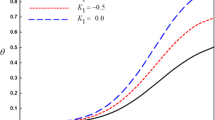Abstract
Alternative growth and decay estimates, reminiscent of the classical Phragmén-Lindelöf principle, are derived for a linearised thermoelastic body whose plane cross-sections increase unboundedly with respect to a given direction. The proof uses a modified Poincaré inequality to construct a differential inequality for a weighted linear combination of the cross-sectional mechanical and thermal energy fluxes. Decay estimates are deduced also for the cross-sectional mean square measures of the displacement and temperature. An explicit upper bound in terms of base data is established for the amplitude occurring in the decay estimates.


Similar content being viewed by others
Notes
This assumption can be made explicit. For instance we can assume that (v i ,φ) tend to zero exponentially in the x 1 component, and uniformly with respect to (x 2,x 3).
References
D’Apice, C., Ciarletta, M., Chiriţă, S.: Saint-Venant decay rates for an inhomogeneous isotropic linear thermoelastic strip. J. Math. Anal. Appl. 381, 121–133 (2011)
Flavin, J.N., Knops, R.J., Payne, L.E.: Decay estimates for the constrained elastic cylinder of variable cross-section. Q. Appl. Math. 47, 325–350 (1989)
Gradshteyn, I.S., Ryzhik, I.M.: In: Jeffrey, A. (ed.) Table of Integrals, Series, and Products, 5th edn. Academic Press, Boston (1995) (Translated from the Russian)
Hardy, G.H., Littlewood, J.E., Pólya, G.: Inequalities, 2nd edn. Cambridge University Press, Cambridge (1952)
Knops, R.J., Rionero, S., Payne, L.E.: Saint-Venant’s principle on unbounded domains. Proc. R. Soc. Edinb. 115A, 319–336 (1990)
Lupoli, C.: A Phragmén-Lindelöf principle for the thermoelastic cylinder of variable cross-section. Meccanica 28, 315–325 (1993)
Author information
Authors and Affiliations
Corresponding author
Additional information
R. Quintanilla has been supported by the Project “Anáisis Matemático de las Ecuaciones en Derivada Parciales del Termomecánica” (MTM2013-42004-P) of the Spanish Ministry of Economy and Competitiveness.
Appendix: Particular choices of γ 1,γ 2
Appendix: Particular choices of γ 1,γ 2
This Appendix presents three methods for selecting the positive constants γ 1,γ 2, that lead to different growth and decay rates. Of course, γ 1 is assumed always to satisfy condition (5.8), but additional conditions are also imposed which curtail the applicability of the general procedure.
1.1 A.1 Method 1
The first selection of γ 1 and γ 2 is taken to ensure that
and yields the choice
The corresponding growth and decay rates become proportional to
The maximum value of (C ∗)−1 is not easily determined from an examination of its derivative. Instead, we introduce the positive constant M 4 that satisfies
and set
to obtain from (A.3)
We now select
where p>0. In order to satisfy (5.9) and (A.4), we require
the last inequality being derived from the properties k>1, d≥1, which are valid by definition of k and d. Substitution of (A.7) in (A.6) leads to corresponding rates of growth and decay as previously explained. Note that p cannot be arbitrarily small (and therefore M 4 arbitrarily large) since (A.5) implies that then λ→∞ and μ→0, while λμ→∞, and the definitions of Λ(z) and F(z) are invalidated.
1.2 A.2 Method 2
Indicative rates may be provided for certain geometries by taking \(\gamma_{2}=\bar{\gamma_{2}}\), defined in (6.16), and γ 1 to be the mean value of the range (5.8); that is, we insert
into (6.21) to obtain the rate of growth and decay proportional to (C ∗)−1. Routine calculations show that
Now suppose that
which is satisfied when, by virtue of (3.19), we put keC=1−ε, 0<ε<1, and take ε, or h, sufficiently small for any given C. Next, set
which from (5.9) requires that
which always holds provided C lies in the range
and
The last condition is valid for sufficiently large e.
Then we have
where
and is positive by virtue of assumption (A.10).
Subject to the above stated conditions, growth and decay rates now follow as described previously.
1.3 A.3 Method 3
A third possible choice of constants consists in putting
for arbitrary positive constant C 2 and where b is given by (3.17). The estimate (4.8) is replaced by
where
Consequently, Lemma 2 holds for arbitrarily large positive constant C 2. We restrict, however, the constant to satisfy 0<C 2<1. It will become apparent in what follows that while the choice (A.13) leads to certain simplications, it presents difficulties when determining optimum growth and decay rates.
To proceed, we further set
which in conjunction with (5.9) implies that \(C^{2}_{2}<1\), while definitions (5.6) and (5.7) reduce to
It follows from (A.13) and (A.14) that
and that the lower bound (5.5) becomes
For the particular choice of γ 2, we set
Subject to the further special choices (A.13) and (A.15), we then have
On substituting from (A.16), (A.17), (A.21), and (A.22) in (5.4) and (5.11) we conclude that
where we have used (A.14), and set
The differential inequality (A.25) is consistent with the generic form whose integration has been previously discussed.
It has already been remarked that optimum growth and decay rates are achieved for minimum values of the generic constant C ∗. That is, for the present special choice of γ 1,γ 2, we wish to choose C 2 to ensure that
is a maximum, where
It follows in these circumstances that the optimum value q of C ∗, attained in the limit C 2→0, is not achievable because several quantities entering into the above calculations become unbounded rendering the conclusions meaningless. In particular, note that from (A.15), in the limit we also have λμ→∞, so that either λ or μ or both must be infinite invalidating the choice of Λ(z) or F(z) or both.
Of course, explicit rates are obtained upon selecting a definite value for C 2 in the interval 0<C 2<1, say C 2=0.25. Details are omitted.
Rights and permissions
About this article
Cite this article
Knops, R.J., Quintanilla, R. Spatial Behaviour in Thermoelastostatic Cylinders of Indefinitely Increasing Cross-Section. J Elast 121, 89–117 (2015). https://doi.org/10.1007/s10659-015-9523-8
Received:
Published:
Issue Date:
DOI: https://doi.org/10.1007/s10659-015-9523-8



